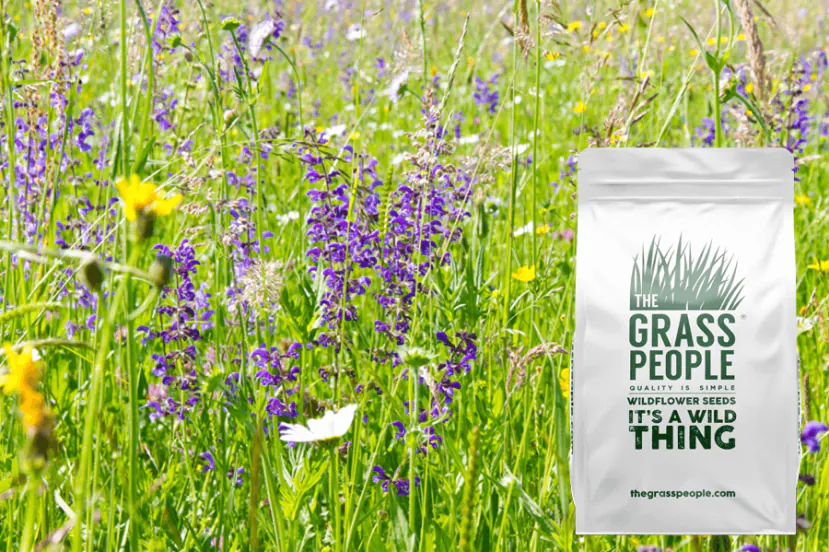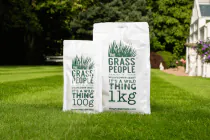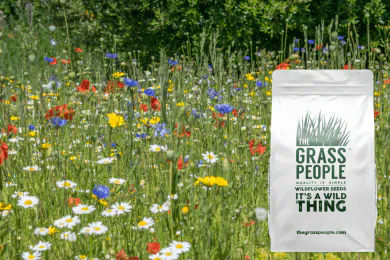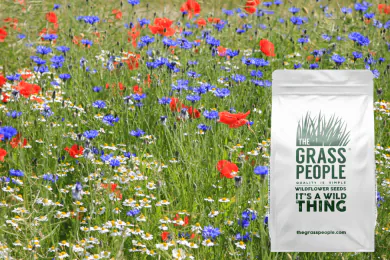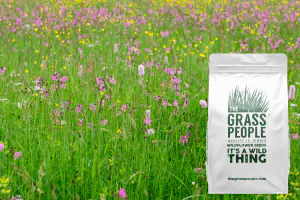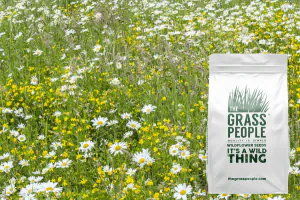Shaded Areas Wildflowers
- Creates a meadow of wildflowers that can grow in little light
- Helps to provide a canopy habitat for pollinators and wildlife
- Makes use of forgotten-about shady spaces
Please refresh the page in 1 minute to see the next delivery time.
How much do I need?
Simply enter the length and width of the area, to calculate how much you need.
Product Description
Growing wildflowers in shady spaces doesn’t have to be difficult – all you need is the right seed! We cultivated this Shaded Area wildflower mix, so that it contains only the wildflowers that are the very best at growing in little light and are similar to what you would find growing naturally beneath trees or in a woodland setting. With annuals, perennials and grass - this mix will help you to create the meadow you’ve longed for in the darker parts of your garden. Containing RHS Plants for Pollinators wildflowers, this mix will attact bees and other pollinators.
Mixture Breakdown
June - October
What colour is it?Purple
Annual or Perennial?Perennial
Latin NameStachys sylvatica
DescriptionThese plants have dark green, hairy stems with tight whorls of purple flowers at the top.
March – November
What colour is it?Pink
Annual or Perennial?Perennial
Latin NameSilene dioica
DescriptionRed Campion has hot pink petals that make for quite the show stopper in your wildflower meadow, and can typically be found in woodland areas. Red Campion begins to flower once bluebells begin to fade, so if you notice this happening in your wildflower sward you can begin to look forward to their fuchsia blooms!
June – August
What colour is it?Red / Black
Annual or Perennial?Annual
Latin NamePapaver rhoeas
DescriptionCorn Poppy is a vibrant and bright addition to any meadow and easily recognisable and identifiable throughout the UK. Of course it has meaning for many, and also adds a colourful pop to any wildflower plot
April – May
What colour is it?Violet
Annual or Perennial?Annual
Latin NameHyacinthoides non-scripta
DescriptionHow can you not love this woodland wildflower that can often be found growing underneath trees or dark moist spaces! Sadly, native UK bluebells are under threat from Spanish Bluebells, that are lot more ruthless in their rooting. Luckily, this mix contains UK native Bluebells!
May – November
What colour is it?Yellow
Annual or Perennial?Perennial
Latin NameGeum urbanum
DescriptionWood Avens can be naturally found in dark and warm spaces and brightens them up with its yellow star-like petals
April - June
What colour is it?Blue
Annual or Perennial?Annual
Latin NameMyosotis scorpioides
DescriptionThis plant has blue, cloud-like flowers with five petals that grow on the end of tall, hairy stems which can sometimes grow up to 2 feet in height.
May - August
What colour is it?Purple
Annual or Perennial?Perennial
Latin NameHesperis matronalis
DescriptionThis short lived perennial has purple and white flowers with 4 petals. It is also an important source of food for different types of butterflies.
June - October
What colour is it?Purple
Annual or Perennial?Perennial
Latin NameStachys officinalis
DescriptionBetony is related to the nettle family and produces bright magenta blooms. It is thought that when you see Betony, it is an indication that ancient woodlands are near.
July - September
What colour is it?Green / Yellow
Annual or Perennial?Perennial
Latin NameTeucrium scorodonia
DescriptionWood sage has rough, crinkled leaves, similar to the leaves of sage. When it blooms, it produces light yellow flowers that pollinators love.
May - October
What colour is it?White
Annual or Perennial?Perennial
Latin NameSilene latifolia
DescriptionThe white sibling of Red Campion, this wildflower still holds it on with its lengthy rayed petals. At night time it is said to produce a clover scent that is attractive to many bees and pollinators.
July - September
What colour is it?White
Annual or Perennial?Annual
Latin NameTorilis japonica
DescriptionThese plants are fast growing with thick hairy stems. Its white flowers grow in clusters just above the stem.
April – June
What colour is it?White
Annual or Perennial?Perennial
Latin NameAlliaria petiolate
DescriptionGarlic Mustard is a pretty white perennial that can be typically found in hedgerows and woodland where it thrives in dark and moist soils. If you're wondering how it got Garlic in its name, when its leaves are crushed they smell of it!
May – September
What colour is it?Purple
Annual or Perennial?Annual
Latin NameAgrostemma githago
DescriptionCorncockle is a pretty purple wildflower with tall stems and full petals and is a bright addition to any annuals mix. It is currently rare and endangered.
June - September
What colour is it?White
Annual or Perennial?Perennial
Latin NameFilipendula ulmaria
DescriptionMeadow Sweet produces frothy clusters of sweet-smelling white flowers. It can be found and favours woodland shaded areas with damp soil
April - June
What colour is it?White
Annual or Perennial?Perennial
Latin NameAllium ursinum
DescriptionThis plant has long, broad, green leaves with one main vein. The small, white flowers on this plant grow in groups at the end of the stem. This plant has a pungent, garlic smell.
June - September
What colour is it?Yellow
Annual or Perennial?Annual
Latin NameHypericum perforatum
DescriptionThe flowers on this plant are bright yellow and star-shaped, with small small black dots scattered across them.
June - September
What colour is it?White
Annual or Perennial?Perennial
Latin NameDaucus carota
DescriptionPart of the carrot family, Wild Carrot smells like carrots but is not the kind of one you would want to eat. Its low nutrient and drought tolerant abilities make it ideal for shaded areas.
May - June
What colour is it?White
Annual or Perennial?Perennial
Latin NameAnthriscus sylvestris
DescriptionCow Parsley is a shade tolerant wildflower that can be found naturally growing in woodland areas and its stem branches out into many clusters of tiny white flowers. It is sometimes referred to as 'Queen Anne's Lace' as it was said it would bloom for Queen Anne and her ladies in waiting and resembled the lace on their dresses.
June – September
What colour is it?Pink / Purple
Annual or Perennial?Perennial
Latin NameDigitalis purpurea
DescriptionFoxgloves are biennial wildflowers that when sown will reward you with blooms for two whole years. Their bright pink / purple bells are attractive to bees and pollinators who tunnel in to feed on its nectar.
May to September
What colour is it?White
Annual or Perennial?Perennial
Latin NameSilene vulgaris
DescriptionThis perennial plant gets its name from its bladder-like calyx with purple veins, just behind the flowers. The flowers have 5 2-lobed petals and are white in colour.
This is a grass seed and typically germinates at temperatures of 8 -10 degrees
What colour is it?Green / Beige
Annual or Perennial?Perennial
Latin NameFestuca arundinacea
DescriptionTall Fescue is a grass that performs in most soil types
This is a grass seed and typically germinates at temperatures of 8 -10 degrees
What colour is it?Green / Beige
Annual or Perennial?Perennial
Latin NameFestuca rubra
DescriptionSlender Creeping Red Fescue is a grass that performs in most soil types
This is a grass seed and typically germinates at temperatures of 8 -10 degrees
What colour is it?Green / Beige
Annual or Perennial?Perennial
Latin NameFestuca rubra
DescriptionStrong Creeping Red Fescue is a grass that performs in most soil types
This is a grass seed and typically germinates at temperatures of 8 -10 degrees
What colour is it?Green / Beige
Annual or Perennial?Perennial
Latin NameCynosurus cristatus
DescriptionCrested Dogstail is a grass that performs in most soil types
This is a grass seed and typically germinates at temperatures of 8 -10 degrees
What colour is it?Green / Beige
Annual or Perennial?Perennial
Latin NamePoa nemoralis
DescriptionWood Meadow Grass is a grass that performs in most soil types
Usage Guide
● Remove any existing grass, plants or flora from the area where you plan to sow your wildflower seed. Failure to do this will produce poor results
● Further remove the top 5-10cm to reduce soil fertility
● Allow the area to cultivate for several weeks, and remove any weeds that may pop in the area during this time
● Do not be tempted to add top soil, compost or fertiliser to the area - wildflowers prefer low nutrient conditions
● After the cultivation period ensure to remove stones or any other debris and rake the area to create a fine, friable and level seedbed
● Scatter the seed at a rate of 5g per m2
● Rake the seed so that it is in amongst the soil
● Water the just-sown wildflower seed well
● If sowing in drought conditions, water as required to keep the area moist in the first 6 weeks after sowing
Read our full guide on how to manage your wildflower meadow here.
| Sowing Rate | 5g per m2 |
| Sowing Depth | 20 - 40mm |
| When | For best results sow in September |
Aftercare
End of year cut:
- We recommend doing this essential end-of-year cut in autumn.
- Your wildflowers are ready for their first cut when they have grown to 7cm and have gone to seedhead.
- This cut can be done using your lawn mower at its highest setting or using a strimmer.
Early spring cut:
- An early spring cut is ideal when your wildflowers are well-established.
- This early spring cut trims back meadow grasses and helps increase the density of the wildflowers.
- This cut also encourages wildflowers to grow better later that season.
- Cut before the end of April, or you may stunt their growth, and they could skip blooming that year.
Summer cut (optional):
- A cut between June and August can encourage the growth of wildflowers later in the season.
- Cut back to 7cm tall and remove the cuttings.
- This optional cut encourages new wildflowers to grow and flourish.
What to do with the cuttings (if you have annual wildflowers in the mix):
In dry conditions:
- If conditions will be dry for 5-7 days, you can let the cuttings lie on the ground so the seeds drop.
- Walk over, use a roller or shake the seedheads to encourage the seeds to fall and grow next season.
- Then remove the plant cuttings after a week and dispose of them in your garden waste bin.
In wet conditions:
- Lift the clippings if rainfall is forecast, and manually free up the seeds by crushing the seedhead to collect the seeds for replanting.
- When dry conditions return, scatter the seeds across your wildflower area.
- Alternatively, you can store your collected wildflower seeds in an envelope and replant them later.
For further reading, check out our guide on when and how often to cut a wildflower meadow.
The above photo depicts the variety of species you should expect to see in your wildflower display. Please note that certain species within this mix and all our wildflower mixes may become more abundant than others, and this varies based on the conditions in which they are sown. Taking this into consideration, your wildflower meadow will evolve and adapt year after year and change in appearance as certain species may become more dominant than others.
Product Questions
Product Questions
Thank you
Many Thanks
Kind Regards,
Roisin
Technical Advisor
Should I choose seen for shaded area or will "normal" seed cope with the light conditions. I plan to sow in September after fully clearing the site.
Thanks.
Our Shaded Area Wildflowers is specifically for shaded areas. It consists of annual and perennial wildflowers and grasses that will tolerate damp and shady areas that do not always receive sunlight.
We do not recommend allowing pets to graze on wildflowers. Whilst most are safe, there can be few such as Buttercups and Foxgloves that are poisonous to animals and can be to humans. Each of these wildflowers have minor to moderate toxicity and can prove fatal if consumed / ingested in any amount. Therefore, we would not recommend sowing any of our wildflower seed mixes, or any others, near your children or pets if you have concerns that they would consume them.
It is called, When should I sow wildflowers? This goes into more detail about sowing wildflowers at different times.
I have some very steep banks in my north east facing garden - so naturally fairly shady - and plan to seed with wildflower and grasses. Is this seed mix suitable for planting on banks…and how would I retain the seed when watering in the early days (I have a vision of a bare bank with lots of flowers and grass at the bottom where the seed has slid down the bank!)
Many thanks
Will they flower all year round?
Thanks.
If you plan to sow now wildflowers will bloom from spring through the summer but not all year. If there are grasses within the mix then these will be the first to show and will be around for longer. If your garden has limited access to sunlight even during the summer months then I would recommend the shaded mix. It is a mix of annuals, perennials and grasses that will tolerate and establish in damp and shaded areas.
